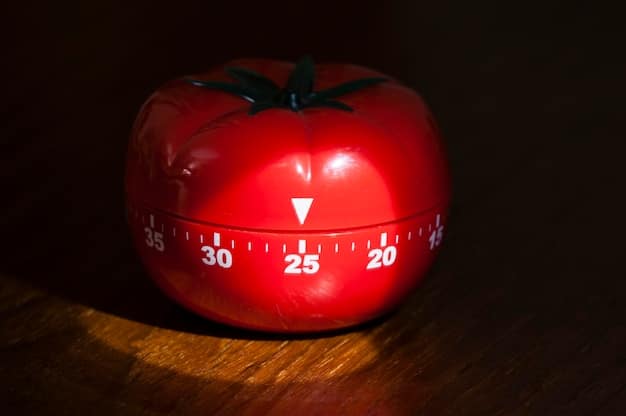Regular Breaks: Boost Performance & Recharge Your Mind

The Importance of Regular Breaks: Recharging Your Mind and Body for Optimal Performance involves strategically incorporating short rests into your routine to enhance focus, prevent burnout, and improve overall well-being, ultimately leading to higher productivity and job satisfaction.
In today’s fast-paced world, it’s easy to get caught up in the grind. But did you know that stepping away from your work – taking regular breaks – can actually boost your productivity and well-being? Understanding the importance of regular breaks: recharging your mind and body for optimal performance is key to unlocking your full potential.
The Science Behind Breaks: Why They Work
Many perceive taking breaks as unproductive, yet the evidence suggests otherwise. Our brains, like any muscle, require rest to function optimally. Understanding the science behind why breaks are effective can help you prioritize them in your daily routine.
Combating Decision Fatigue
Our ability to make sound decisions deteriorates with prolonged mental exertion. Taking a break allows your brain to reset, recovering its ability to make objective decisions.
The Pomodoro Technique: A Structured Approach
The Pomodoro Technique, involving focused work intervals followed by short breaks, is a prime example of leveraging the science of breaks for enhanced productivity.

Restoring Cognitive Function
Regular breaks allow the brain to consolidate information, improving memory and overall cognitive function.
- Reduced Stress Levels: Breaks provide a physiological respite from the demands of work.
- Improved Focus: Stepping away allows you to return to your tasks with renewed concentration.
- Enhanced Creativity: Breaks can stimulate creative thinking and problem-solving.
- Increased Motivation: Taking time off can boost morale and reinvigorate your commitment.
In conclusion, taking breaks isn’t a sign of weakness, but a strategic tool for enhancing cognitive function and overall performance. By understanding the science behind breaks, you can leverage them to optimize your productivity and well-being.
Types of Breaks: Tailoring to Your Needs
Not all breaks are created equal. To maximize the benefits, it’s important to consider the duration, frequency, and type of break that best suits your needs and work environment. A variety of breaks can lead to greater overall rejuvenation.
Micro-Breaks: The Quick Recharge
Micro-breaks are short respites, typically lasting a few seconds to a few minutes, and can involve simple activities like stretching or deep breathing. These short breaks accumulate to provide great value
Active Breaks: Movement for Mental Clarity
Active breaks involve physical activity, such as walking, stretching, or doing a quick workout. This can energize the body and mind.
Mindful Breaks: Centering Yourself
Practicing mindfulness or meditation during breaks can reduce stress and improve focus. This can be done with a guided app or simply by becoming aware of breath and surrounding.
- Social Breaks: Interacting with colleagues or friends can provide a welcome distraction and boost morale.
- Nature Breaks: Spending time outdoors, even for a few minutes, can have a calming and restorative effect.
- Creative Breaks: Engaging in creative activities, such as drawing or writing, can stimulate different areas of the brain.
In this section, we explored different types of breaks, tailoring them to individual needs for effective rejuvenation. By incorporating a mix of micro, active, mindful, and social breaks, you can recharge your mind and body for optimal performance.
The Costs of Not Taking Breaks: Burnout and Reduced Productivity
Ignoring the need for regular breaks can have significant negative consequences, affecting both your physical and mental health and your work performance. Understanding these costs can provide the motivation to prioritize rest.
Symptoms of Burnout
Burnout manifests in various ways, including exhaustion, cynicism, and reduced professional efficacy. Recognizing these symptoms early can help you take corrective action.
Decreased Focus and Concentration
Without regular breaks, your ability to focus and concentrate diminishes, leading to errors and decreased efficiency. This not only hurts your productivity but also causes more stress.

Increased Stress and Anxiety
The cumulative effect of not taking breaks is heightened stress and anxiety levels, which can lead to long-term health problems. Prioritizing breaks reduces stress and helps with your mental health.
- Reduced Creativity: A mentally exhausted mind is less likely to generate creative ideas and solutions.
- Poor Work-Life Balance: Neglecting breaks often leads to blurred boundaries between work and personal life.
- Health Problems: Chronic stress and lack of rest can contribute to various health issues.
To conclude, we’ve seen the costs of not taking breaks can impact physical and mental health. By understanding the symptoms of burnout and the negative effects on focus, stress, and creativity, you can take proactive steps to prevent these issues.
Integrating Breaks into Your Workday: Practical Tips
Now that we understand the benefits and consequences of breaks, let’s explore practical strategies for incorporating them into your daily routine. These tips can help you seamlessly integrate breaks into your workday without disruption.
Schedule Breaks in Your Calendar
Treat breaks as important appointments and block them out in your calendar. This helps you prioritize them and avoid scheduling conflicts.
Use Technology to Your Advantage
Utilize apps and tools that remind you to take breaks and guide you through relaxation exercises. These are often customized and effective to you.
Create a Dedicated Break Space
Designate a comfortable area in your workplace or home where you can fully relax and disconnect. Even a quick walk in nature can provide calm.
- Set Boundaries: Communicate to colleagues or family members that you are unavailable during your break time.
- Vary Your Activities: Rotate between different types of breaks to keep things interesting and address various needs.
- Be Mindful of Your Body: Pay attention to your body’s signals and take breaks when you feel tired or stressed.
In summary, integrating breaks into your workday requires careful planning. By scheduling breaks, using technology, creating a break space, setting boundaries, and varying your activities, you can make breaks a routine part of your day.
Overcoming the Guilt of Taking Breaks: A Mindset Shift
One of the biggest challenges in taking regular breaks is overcoming the guilt associated with stepping away from work. Recognize value in a brief moment to yourself as you adjust your perspective.
Reframe Breaks as an Investment
Think of breaks not as a waste of time but as an investment in your productivity and well-being. The outcome is boosted creativity, focus, and efficiency.
Recognize Your Limits
Acknowledge that you are not a machine and that your cognitive resources are finite. Be kind and realistic about how much work you can productively take on.
Track Your Productivity
Monitor your output on days when you take regular breaks versus days when you don’t, and you will see that productivity is optimized with breaks.
- Celebrate Small Wins: Acknowledge and appreciate the positive impact of breaks on your work and mood.
- Challenge Negative Thoughts: Actively combat any guilt or self-criticism that arises when you take a break.
- Focus on the Long-Term: Understand that prioritizing rest will lead to sustained productivity and prevent burnout.
In brief, we have seen that overcoming the guilt, you can reframe breaks as a necessary investment improving all aspects of your life. By recognizing limits, tracking productivity, celebrating small wins, challenging negative thoughts, and focusing on the long-term benefits, you can successfully shift your mindset.
Measuring the Impact: How to Track the Effectiveness of Your Breaks
To ensure that your breaks are truly beneficial, it’s important to track their impact on your productivity, focus, and well-being. This section provides guidance on how to measure the effectiveness of your breaks.
Use a Productivity Tracker
Utilize productivity tracking tools to monitor your output before and after implementing regular breaks. This will highlight any gains from break usage.
Keep a Journal
Record your energy levels, mood, and focus throughout the workday, noting the effects of your breaks. This will assist in understanding any impacts on well-being.
Gather Feedback from Colleagues
Solicit input from your coworkers on your performance and demeanor. This can reveal any shifts in attitude and efficiency.
- Set Clear Goals: Define specific objectives for your breaks (e.g., reducing stress, improving focus) and measure progress towards those goals.
- Monitor Your Sleep: Track your sleep quality, as breaks can indirectly impact your sleep patterns.
- Adjust Your Approach: Based on your findings, refine your break routine to optimize its effectiveness.
In summary, measuring the impact of breaks requires diligent effort. By using a productivity tracker, keeping a journal, gathering feedback, setting clear goals, monitoring sleep, and adjusting your approach, you can measure the efficacy and make the appropriate adjustments accordingly.
| Key Point | Brief Description |
|---|---|
| ⏰ Scheduled Breaks | Treat breaks as essential appointments in your calendar. |
| 🚶♀️ Active Breaks | Incorporate physical activity for mental clarity and energy boost. |
| 🧠 Mindset Shift | Reframe breaks as an investment in your productivity and well-being. |
| 📊 Track Impact | Measure the effectiveness of your breaks with trackers and journals. |
[FAQ Section]
▼
The frequency of breaks depends on the nature of your work. A general guideline is to take a short break (5-10 minutes) every hour or a longer break (20-30 minutes) every 2-3 hours. Adjust based on your energy levels.
▼
Good activities for short breaks include stretching, walking around, deep breathing exercises, listening to music, or having a quick conversation with a colleague. The goal is to disconnect from your work.
▼
Reframe breaks as an investment in your productivity and well-being. Remind yourself that taking breaks will help you return to your work with increased focus and energy, ultimately improving your efficiency.
▼
Yes, breaks can significantly enhance creativity. Stepping away from a problem allows your subconscious mind to continue processing it, often leading to new insights and innovative solutions when you return to the task.
▼
Even in demanding jobs, you can find small moments for respite. Incorporate micro-breaks, such as stretching at your desk or taking a few deep breaths, and communicate the importance of breaks to your employer if feasible.
Conclusion
In conclusion, the importance of regular breaks: recharging your mind and body for optimal performance cannot be overstated. By integrating strategic breaks into your daily routine, you can enhance focus, prevent burnout, and improve your overall well-being, leading to increased productivity and job satisfaction.





